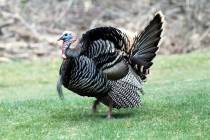When seeking stripers, think and act like a trout
Word from the fishing front is action for stripers is picking up on Lake Mead and Lake Mohave. I even have received reports that a handful of stripers tipping the scale at more than 30 pounds have been caught in the upper reaches of Mohave. Given the fishing history of that water, I have no reason to doubt those reports.
As a general rule, big stripers are taken on big plugs or swimbaits. Sure, they'll take an anchovy now and again, but when I hear about truly large fish, the story usually includes the description of a large plug that resembles rainbow trout.
One plug that often is associated with big stripers, and with a variety of other large freshwater species, is the AC Plug. The plug's creator, Allan Cole of Henderson, owns the Nevada state striper record with a 63-pound fish he pulled from the Cottonwood Cove area of Lake Mohave while throwing his own plug -- a large wooden lure designed to resemble rainbow trout.
Some say the term "swimbait" was coined after a game warden told Cole his lure looks and swims like a trout.
Arizona's state record striper, a 67-pounder, was taken from the Colorado River, probably near Willow Beach, by Jeff Smith in August 1997. It, too, was taken on an AC Plug.
I never have used the AC Plug, so when the opportunity presented itself, I asked Cole for tips.
"Basically, stripers will hit near the surface," Cole said. "You either cast it or you troll it. And you basically want to go slow, right on top (of the water) or just under. Or, if you troll a little quicker, it will dive from 6 to 10 feet. It's all productive."
Cole said when casting his plug, retrieval speed is key for fishing success because the lure is designed to mimic trout that seem to exhibit some type of mental deficiency.
"You want to go slower. Fast is somewhat effective, (but) it's better to go slow, even dead slow, because my lure basically mimics a low-IQ trout. That's the one they key on. And so the slower you go -- that thing's got that wiggle with it, and, with that soft plastic tail, it gets an action that they can't resist. That's how they get caught."
When seeking stripers, Cole likes to fish near structures and places where fish can hide. He said anglers should look for submerged brush and drop-offs. The fish will hang out in the shallows, but he said fish hanging out in shallow water are tricky, so you have to use stealthy tactics and a trolling motor.
But the bottom line is you have to "think like a trout that's being chased" and fish where they might hide from a hungry striper or largemouth bass.
Cole is so convinced that mimicking trout is the best way to catch big bass that he entered the world of plastic swimbaits with an offering called the Casitas, after his favorite California bass lake. After so many successful years with his wooden plugs, I wondered why he decided to get into the world of plastics.
"I've always had wooden lures," he said, "and I wanted a soft plastic because it's a different technique, mainly for largemouth bass like the big ones in California or even bass here at Lake Mead or Lake Mohave. The soft plastic doesn't have as much action, but the tail wiggles, and it's real effective on big largemouth."
The new swimbait is made from a mold taken of a living trout. I guess time will tell.
• BIG-GAME TAGS -- The Clark County Advisory Board to Manage Wildlife will meet at 6 p.m. Tuesday at the Clark County Government Center.
On the agenda are recommendations from the Tag Allocation and Application Hunt Committee to change regulations regarding the total number of applications a junior hunter is eligible to submit while still considered a junior hunter. Also to be discussed is the transfer of bonus points to the antlered deer category in the main tag draw once a young hunter no longer is eligible to participate in the draw as a junior.
Other agenda items include a youth upland game season, season dates and bag limits for waterfowl, and deadline changes for the return card questionnaire.
Doug Nielsen is an award-winning freelance writer and a conservation educator for the Nevada Department of Wildlife. His "In the Outdoors" column is published Thursday. He can be reached at doug@takinitoutside.com.
C. DOUGLAS NIELSENMORE
COLUMNS

















